Introduction and Package

It's been ages since we've seen anything from Palit and really it's for good reason. Let's be honest, up until now, it's been a quiet succession of months for NVIDIA when it comes to the video card market and that means for NVIDIA GPU only partners, it's been very quiet for them.
We should start to see that all change over the coming months, not only because we have the new GTX 680, but we'll see NVIDIA fill out the GTX 600 series line over the next few months while we then see their partners offer us fancy new variants of the model. Next up we'll see the GTX 670 in May of course followed by the GTX 660, 650 and low-end models.
Speaking of fancy new variants, though, we didn't expect to see one this close to launch. Palit has just released their own GTX 680 which falls under the brand new JetStream series. We knew that Palit would come to the party quickly with a fancy new variant, but we can honestly say we didn't think it would be this quickly with the model only officially launching last week.
What was so great about the new card, though, is we really get a chance to flex our location muscle these days. As the cards just arrived into the Palit HQ in Taiwan and moved up from R&D, we got a phone call telling us that we could come in and pick it up the same day, well ahead of any other media.
No more do we have to wait for courier companies or worry about Mother Nature messing with our card in transit. We made our way down to Palit and got a chance to pick up the card in person and also talk about some of the main features along with the new series on a whole with our friendly marketing contact there.
So, with that said, let's look at the package of the card. Once we've done that we'll move onto the card itself and see just what Palit are offering us before looking at the specification side of things. Once we've done that we'll look over our testbed and get into the performance side of things to see just what kind of performance this brand new GTX 680 from Palit can offer us.
Package




Normally we wouldn't go into too much detail on the box these days but; Oh My God! Palit has done a fantastic job with the new package design. It looks awesome and it feels so much more grown up. I always loved "Frobot", I thought he was kind of cool. But it did feel a little childish, the new JetStream packaging looks great, though, and the Black and Gold theme looks perfect. The Chinese character of "fong" (wind in English) appears in many places and is very stylish.
Inside the box we've also got a really good description of the cooler and some of the main features that the card offers. Hopefully we're not dealing with just some marketing talk and instead get to see a product that really stands out here.

As for the bundle there is a manual, driver CD, DVI to VGA connector, HDMI to DVI connector and dual 6-pin PCI Express to 8-pin PCI Express power connector. Palit have never been big on bundles and we're actually seeing more and more companies choose to shrink them and spend more time on the video card itself, which is ultimately going to end up being the best thing to do.
The Card and Specifications
The Card

Moving onto the card we've got a massive three fan design that looks awesome. We see the same black and gold theme and you can see behind the fans we've just got a massive heatsink going on. We can also see the Palit logo on one end while the new JetStream one is seen on the other. So, team this video card up with an upcoming ASRock or ECS Z77 motherboard and you'll have some pretty wicked color matching. Gold is making a comeback, that's for sure.

Looking around the card we can see one of the heatpipes present here while the power connector has also been mixed up a bit. Instead of the dual 6-pin PCI Express power connector setup we can see that Palit has opted for an 8-pin and 6-pin setup which works well with the six phase PWM; an upgrade from the four phase setup offered by reference cards.

Closer to the front we can see another one of the heatpipes and the two SLI connectors. While you can run up to four of these cards, the triple slot setup is going to make it impossible. A two card setup would look absolutely killer, though, let alone even talking about 3D performance.

Finally we finish with the I/O side of things and you can see here we've got two DVI connectors, single HDMI port and single DisplayPort connector. We can also see some vents in the top left corner to help push some air out of the back of the case.
Specifications
Having a look below we can see that the Palit JetStream GTX 680 of course comes overclocked out of the box. We can see that the default core clock has been pushed from 1006MHz to 1085MHz and this has in turn pushed the boost clock from 1059MHz to 1150MHz.

As for the 2GB of GDDR5, we can also see that's been boosted from a default 6008MHz QDR to a really strong 6300MHz QDR. Combined with the dynamic overclocking we should see some really strong performance from this video card when compared to the reference one.
Benchmarks - Test System Setup

We would like to thank the following companies for supplying and supporting us with our test system hardware and equipment: Intel, ASUS and Corsair.
Looking above you can see our testbed and as usual there's nothing that has changed since the last time you probably saw it. Instead we'll just get into the card line up we're using today. The most important one is the reference clocked GTX 680 as we want to see what kind of performance increase the overclocked Palit offering gives us.
At the same time we want to see how it sits compared to the GTX 680 when we overclocked it manually. Outside of general FPS performance it will be interesting to see just what kind of cooling performance difference we have between the two setups.
Along with those two we've got the GTX 580, HD 7950, HD 7970, the HD 7970 overclocked and finally the HD 6990 to help us round off the line up here today.
Something that probably has to be remembered here today is that the Dynamic Overclocking feature from NVIDIA helps determine a higher overclock depending on things like temperature. If a cards cooler is stronger, it should in turn also be able to offer us a higher overclock than one that isn't as strong. So with all that said and done I think we can get into the performance side of things.
Let's get started!
The FPS Numbers Explained
When we benchmark our video cards and look at the graphs, we aim to get to a certain level of FPS which we consider playable. While many may argue that the human eye can't see over 24 FPS or 30 FPS, any true gamer will tell you that as we climb higher in Frames Per Seconds (FPS), the overall gameplay feels smoother. There are three numbers we're looking out for when it comes to our benchmarks.
30 FPS - It's the minimum number we aim for when it comes to games. If you're not dropping below 30 FPS during games, you're going to have a nice and smooth gaming experience. The ideal situation is that even in a heavy fire fight, the minimum stays above 30 FPS making sure that you can continue to aim easily or turn the corner with no dramas.
60 FPS - It's the average we look for when we don't have a minimum coming at us. If we're getting an average of 60 FPS, we should have a minimum of 30 FPS or better and as mentioned above, it means we've got some smooth game play happening.
120 FPS - The new number that we've been hunting down over recent months. If you're the owner of a 120 Hz monitor, to get the most out of it you want to get around the 120 FPS mark. Moving from 60 FPS / 60 Hz to 120 FPS / 120 Hz brings with it a certain fluidity that can't really be explained, but instead has to be experienced. Of course, if you're buying a 120 Hz monitor to take advantage of 3D, an average of 120 FPS in our benchmark means that in 3D you will have an average of 60 FPS, which again means you should expect some smooth gameplay.
Benchmarks - 3DMark 11
3DMark 11
Version and / or Patch Used: 1.1
Developer Homepage: http://www.futuremark.com
Product Homepage: http://www.3dmark.com/3dmark11/
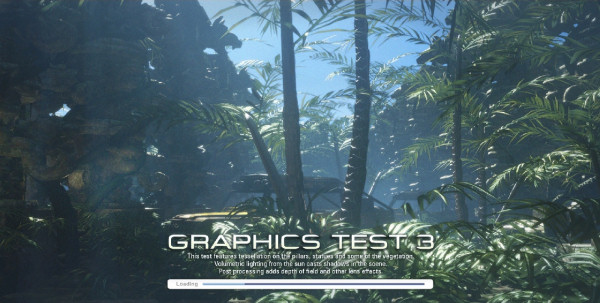
3DMark 11 is the latest version of the world's most popular benchmark. Designed to measure your PC's gaming performance 3DMark 11 makes extensive use of all the new features in DirectX 11 including tessellation, compute shaders and multi-threading. Trusted by gamers worldwide to give accurate and unbiased results, 3DMark 11 is the best way to consistently and reliably test DirectX 11 under game-like loads.

Starting off with 3DMark 11 we can see that performance out of the Palit offering is really strong. We can see that overall it sits right behind the manually overclocked GTX 680 which is great news for Palit. Compared to the other setups, the only AMD offering that comes close is the dual GPU HD 6990.
Benchmarks - Unigine Heaven Benchmark
Unigine Heaven Benchmark
Version and / or Patch Used: 2.5
Developer Homepage: http://www.unigine.com
Product Homepage: http://unigine.com/press-releases/091022-heaven_benchmark//
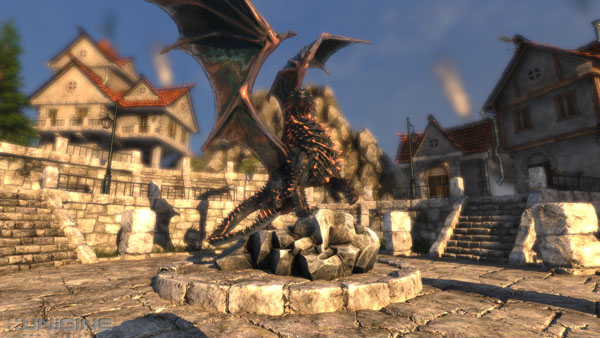
New benchmark grants the power to unleash the DirectX 11 potential in the gift wrapping of impressively towering graphics capabilities. It reveals the enchanting magic of floating islands with a tiny village hidden in the cloudy skies. With the interactive mode emerging experience of exploring the intricate world is ensured within reach. Through its advanced renderer, Unigine is one of the first to set precedence in showcasing the art assets with tessellation, bringing compelling visual finesse, utilizing the technology to the full extend and exhibiting the possibilities of enriching 3D gaming.

Moving into Heaven we again see some great performance and you can see that on the AMD front there's nothing that wins out against the JetStream GTX 680 in this case. The only setup that manages to come out ahead is the manually overclocked GTX 680.
Benchmarks - Tom Clancy's H.A.W.X. 2
Tom Clancy's H.A.W.X.2
Version and / or Patch Used: Benchmark Demo
Timedemo or Level Used: Built-in Test
Developer Homepage: http://www.ubi.com/UK/default.aspx
Product Homepage: http://www.hawxgame.com/
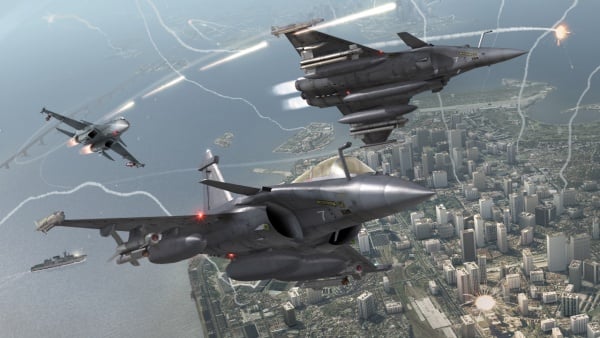
Tom Clancy's H.A.W.X. 2 is an arcade-style flight action game developed by Ubisoft Romania and published by Ubisoft. The game is the sequel to Tom Clancy's H.A.W.X., released in 2009.
The game begins with Colonel David Crenshaw participating in a routine patrol mission in the Middle East. After halting an insurgent attack, a volley of missiles is fired at the Air Force base that Crenshaw was stationed at, with one of the missiles disabling Crenshaw's aircraft, resulting Crenshaw being in enemy captivity. A joint strike force composed of the U.S. Navy, U.S. Air Force, and a Ghost Recon squad executes an operation to rescue Crenshaw. In Scotland, Royal Navy Pilot Colin Munro encounters an unidentified passenger aircraft that explodes from an on-board bomb when undergoing training exercise. In Russia, an air force squadron led by Colonel Denisov and Captain Dmitri Sokov engages separatist aircraft but is ordered to retreat from the region after numerous Russian military installations have been attacked.

Moving over to H.A.W.X. 2 we can see some strong gains again. Overall, though, we've got some very strong FPS out of all our cards here. Especially the NVIDIA ones, though, those have done well under H.A.W.X. 2 since launch.
Benchmarks - Mafia II
Mafia II
Version and / or Patch Used: Latest Steam Update
Timedemo or Level Used: Built in Benchmark
Developer Homepage: http://www.2kczech.com/
Product Homepage: http://www.mafia2game.com/

Mafia II is a third-person action-adventure video game, the sequel to Mafia: The City of Lost Heaven. It is developed by 2K Czech, previously known as Illusion Softworks, and is published by 2K Games. The game is set from 1943 to 1951 in Empire Bay (the name is a reference to New York's state nickname "The Empire State"), a fictional city based on San Francisco and New York City, with influences from Chicago and Detroit. The game features a completely open-ended game map of 10 square miles. No restrictions are included from the start of the game. There are around 50 vehicles in the game, as well as licensed music from the era.

Mafia II performance across the board is really strong and we see nice gains out of the Palit offering when compared to the reference clocked card. You can see we're not far behind that manually overclocked card.
Benchmarks - Lost Planet 2
Lost Planet 2
Version and / or Patch Used: Benchmark Demo
Timedemo or Level Used: Built in Benchmark - Test A Scene 1
Developer Homepage: http://www.capcom.com/
Product Homepage: http://www.lostplanet2game.com/

Lost Planet 2 is a third-person shooter video game developed and published by Capcom. The game is the sequel to Lost Planet: Extreme Condition which is also made by Capcom, taking place ten years after the events of the first game, on the same fictional planet. The story takes place back on E.D.N. III 10 years after the events of the first game. The snow has melted to reveal jungles and more tropical areas that have taken the place of more frozen regions. The plot begins with Mercenaries fighting against Jungle Pirates. After destroying a mine, the Mercenaries continue on to evacuate the area, in which a Category-G Akrid appears and attacks them. After being rescued, they find out their evacuation point (Where the Category-G appeared) was a set-up and no pick up team awaited them. The last words imply possible DLC additions to the game, "There's nothing to be gained by wiping out snow pirates... unless you had some kind of grudge."

Moving into something more intensive like Lost Planet 2 we can see some awesome performance out of the Palit GTX 680 which sees a solid 79 FPS at the super intensive 2560 x 1600 resolution.
Benchmarks - Aliens vs. Predator
Aliens vs. Predator
Version and / or Patch Used: Standalone Benchmark
Timedemo or Level Used: Built in Benchmark
Developer Homepage: http://www.rebellion.co.uk/
Product Homepage: http://www.sega.com/games/aliens-vs-predator/
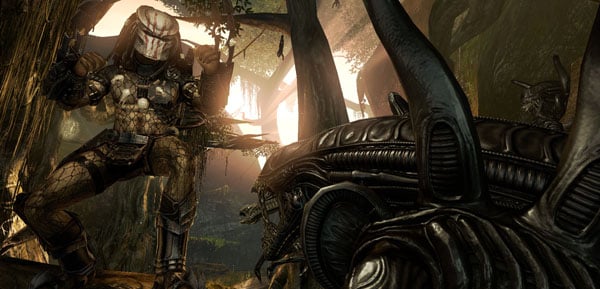
Aliens vs. Predator is a science fiction first-person shooter video game, developed by Rebellion Developments, the team behind the 1999 original PC game, and published by Sega for Microsoft Windows, the PlayStation 3 and the Xbox 360. The game is based on the Alien vs. Predator franchise, a combination of the characters and creatures of the Alien franchise and the Predator franchise. There are three campaigns in the game, one for each race/faction (the Predators, the Aliens and the Colonial Marines), that, while separate in terms of individual plot and gameplay, form one overarching storyline.
Following the storyline of the campaign modes comes the multiplayer aspect of the game. In this Multiplayer section of the game, players face off in various different gametypes in various different ways.

Looking at Aliens vs. Predator we've got some strong performance gains, but the most important one comes at 2560 x 1600 as we see the Palit GTX 680 break into that 60 FPS mark, which we really like to see, for a solid gaming experience.
Benchmarks - Just Cause 2
Just Cause 2
Version and / or Patch Used: 1.0.0.2
Timedemo or Level Used: Dark Tower
Developer Homepage: http://www.eidos.com/
Product Homepage: http://www.justcause.com/
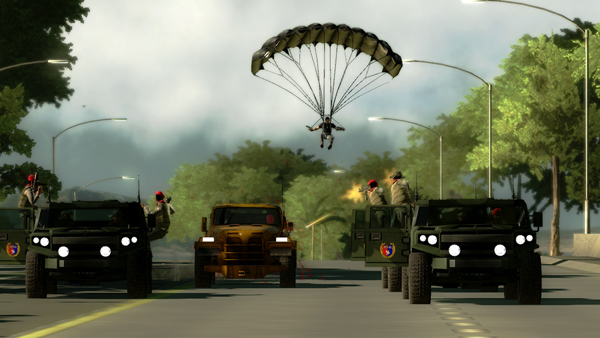
Just Cause 2 employs the Avalanche Engine 2.0, an updated version of the engine used in Just Cause. The game is set on the other side of the world from the original Just Cause, on the fictional island of Panau in Southeast Asia. Panau has varied terrain, from desert to alpine to rainforest. Rico Rodriguez returns as the protagonist, aiming to overthrow the evil dictator Pandak "Baby" Panay and confront his former mentor, Tom Sheldon.

Just Cause 2 performance is also really strong and you can see again we're right on top of that manually overclocked card although it seems like it should be a fair bit faster. At the highest resolution we can see we manage to sneak out an extra FPS when compared to it as well.
Benchmarks - Metro 2033
Metro 2033
Version and / or Patch Used: Latest Steam Update
Timedemo or Level Used: Built in Benchmark
Developer Homepage: http://www.4a-games.com/
Product Homepage: http://www.thqnordic.com/

Metro 2033 is an action-oriented video game with a combination of survival horror and first-person shooter elements. The game is based on the novel Metro 2033 by Russian author Dmitry Glukhovsky. It was developed by 4A Games in Ukraine and released in March 2010 for Microsoft Windows and Xbox 360.[3] In March 2006, 4A Games announced a partnership with Glukhovsky to collaborate on the game.[4] The game was announced at the 2009 Games Convention in Leipzig;[5] a first trailer came along with the announcement.[6] A sequel was announced, currently titled Metro: Last Light.

Metro 2033 as you'd expect also sees some strong performance, but just like Aliens vs. Predator, the most important number comes at 2560 x 1600, where we can see that the overclock again helps us break that 60 FPS barrier that we always aim for to produce a solid gaming experience.
Benchmarks - Dirt 3
Dirt 3
Version and / or Patch Used: Latest Steam Update
Timedemo or Level Used: Built in Benchmark
Developer Homepage: http://www.codemasters.com/
Product Homepage: http://www.dirt3game.com/

DiRT 3 boasts more cars, more locations, more routes and more events than any other game in the series, including over 50 rally cars representing the very best from five decades of the sport. With more than double the track content of 2009's hit, DiRT 3 will see players start at the top as a professional driver, with a top-flight career in competitive off-road racing complimented by the opportunity to express themselves in Gymkhana-style showpiece driving events.

Dirt 3 performance is also very strong and we can across the board see some nice gains that again put the card very close to the manually overclocked card. Of course when you can get that kind of performance out of the box with no manual adjustment, it's always appreciated.
Benchmarks - Far Cry 2
Far Cry 2
Version and / or Patch Used: 1.01
Timedemo or Level Used: Ranch Long
Developer Homepage: http://www.ubi.com/
Product Homepage: http://www.farcry2.com/
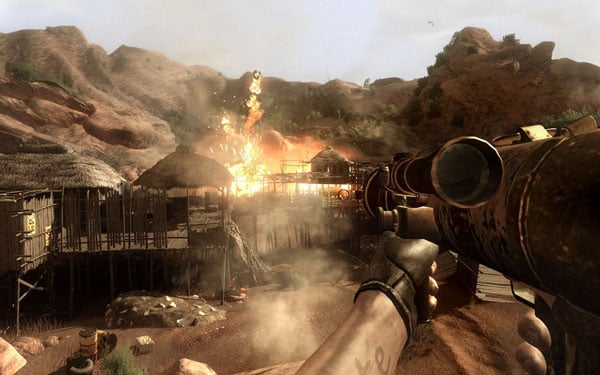
The Dunia Engine was built specifically for Far Cry 2 by the award-winning Ubisoft Montreal development team. It delivers the most realistic destructible environments, amazing special effects such as dynamic fire propagation and storm effects, real-time night-and-day cycle, dynamic music system, non-scripted enemy A.I. and so much more.

Far Cry 2 sees some nice gains, but on these ultra-high end cards, we don't really need the extra FPS.
Benchmarks - High Quality AA and AF
High Quality AA and AF
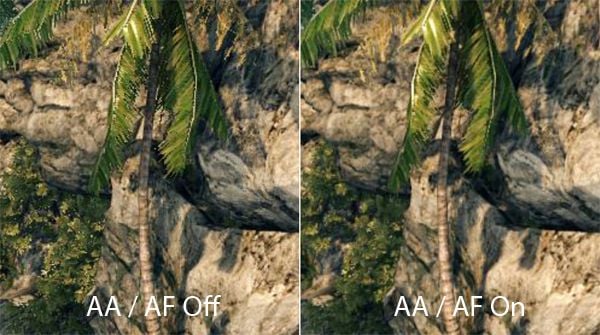
While we test all our games with maximum in-game settings, turning on Anti-Aliasing (AA) and Antistrophic Filtering (AF) helps take the intensity of our testing to another level.
Here we see video cards go from playable FPS to an unplayable FPS and the real power houses continue to help break that 60 FPS mark we always aim for to provide a smooth gaming experience.



With AA and AF on we can see some really strong performance. Unfortunately under Aliens vs. Predator we can see we fall just 2 FPS shy of that 60 FPS mark with the Palit offering, but we're oh so close.
Temperature Test

The temperature of the core is pulled from MSI Afterburner with the max reading used after a completed run off 3DMark Vantage and the Performance preset.

The cooling numbers for the Palit offering is extremely impressive.
For starters the idle is super low, but in the load department, you can see we're sitting 4c cooler than the reference clocked card.
The manually overclocked card is probably a better comparison, though, considering the performance we've got out of the Palit card here and you can see we're 11c cooler when compared to that.
Sound Test

Pulling out the TES 1350A Sound Level Meter we find ourselves quickly yelling into the top of it to see how loud we can be.
After five minutes of that we get a bit more serious and place the device two CM away from the fan on the card to find the maximum noise level of the card when idle (2D mode) and in load (3D mode).

I love what companies are doing with new video cards these days thanks to the strong cooling solutions. You can see that those strong cooling numbers don't come at the cost of noise.
This is another super quiet video card and considering the performance of the card, it's amazing what we're seeing out of this latest generation video cards.
Power Consumption Test

Using our PROVA Power Analyzer WM-01 or "Power Thingy" as it has become quickly known as to our readers, we are now able to find out what kind of power is being used by our test system and the associated graphics cards installed. Keep in mind; it tests the complete system (minus LCD monitor, which is plugged directly into AC wall socket).
There are a few important notes to remember though; while our maximum power is taken in 3DMark06 at the same exact point, we have seen in particular tests the power being drawn as much as 10% more. We test at the exact same stage every time; therefore tests should be very consistent and accurate.
The other thing to remember is that our test system is bare minimum - only a SSD hard drive is used with a single CD ROM and minimal cooling fans.
So while the system might draw 400 watts in our test system, placing it into your own PC with a number of other items, the draw is going to be higher.

Power draw on the Palit GTX 680 is really strong and we can see it comes actually in lower than the reference card in both the idle and load department. Considering the fact that we're dealing with a 6-pin + 8-pin power setup instead of the reference dual 6-pin setup, this is really strong.
Final Thoughts
It's awesome to see Palit again with a new sample as it's really been a while since we've seen anything from them. Of course it's not their fault, it's been pretty quiet for NVIDIA over the last few months and NVIDIA only partners haven't had much to do.
The JetStream GTX 680, though, from Palit just ticks all the right boxes starting with the package which we said looks absolutely amazing. The new design looks really professional and helps highlight the new JetStream series that the company has bought out with a nice touch of the Eastern world. We really look forward to see what else becomes part of the JetStream series over the coming months.
Moving away from the outside of the box we move inside it and in typical Palit fashion it's a little on the light side as far as the package goes. There's not heaps going on, but there's enough to get us going and we're seeing more and more companies offer us less when it comes to bundles in recent months.
The benefit that the smaller bundle brings to the table is that Palit can be a bit more aggressive on the price. While not official, talking to them we're expecting the card to come in at round $20 - $30 more than reference class models. This would continue to put the card in below the HD 7970 and when you're talking about a $500+ video card, you'd be hard press to not want the Palit version over the reference card for only slightly less money.
The base of the video card, the GTX 680, is an awesome platform for Palit. NVIDIA have done a great job with this GPU, they've set it at an awesome price point and performance compared to the AMD offerings is amazing. Working with that, Palit are then able to tweak the card, strap on some brilliant new cooling, and in the end you get this - the Palit JetStream GTX 680 2GB is simply put a beast of a video card.
Again; it's great to see Palit back with a new video card and this new series looks fantastic. We can't wait to see what other models come into the series as NVIDIA expand the GTX 600 range. For now, though, this is a fantastic introduction.


 United
States: Find other tech and computer products like this
over at
United
States: Find other tech and computer products like this
over at  United
Kingdom: Find other tech and computer products like this
over at
United
Kingdom: Find other tech and computer products like this
over at  Australia:
Find other tech and computer products like this over at
Australia:
Find other tech and computer products like this over at  Canada:
Find other tech and computer products like this over at
Canada:
Find other tech and computer products like this over at  Deutschland:
Finde andere Technik- und Computerprodukte wie dieses auf
Deutschland:
Finde andere Technik- und Computerprodukte wie dieses auf